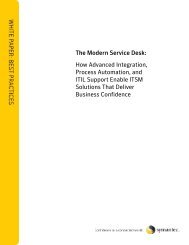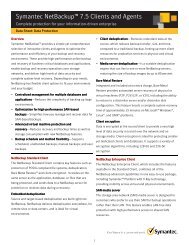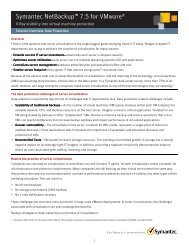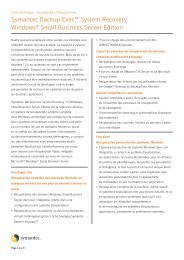Veritas Storage Foundation™ for Oracle® RAC from Symantec
Veritas Storage Foundation™ for Oracle® RAC from Symantec
Veritas Storage Foundation™ for Oracle® RAC from Symantec
Create successful ePaper yourself
Turn your PDF publications into a flip-book with our unique Google optimized e-Paper software.
Data Sheet: <strong>Storage</strong> Management<br />
<strong>Veritas</strong> <strong>Storage</strong> Foundation <strong>for</strong> <strong>Oracle®</strong> <strong>RAC</strong> <strong>from</strong> <strong>Symantec</strong><br />
Manageability and availability <strong>for</strong> <strong>Oracle®</strong> <strong>RAC</strong> databases<br />
Overviewview<br />
<strong>Veritas</strong> <strong>Storage</strong> Foundation <strong>for</strong> <strong>Oracle®</strong> <strong>RAC</strong> <strong>from</strong><br />
<strong>Symantec</strong> offers a proven solution to help customers<br />
implement and manage highly available Real Application<br />
Clusters (<strong>RAC</strong>) databases. The solution leverages<br />
<strong>Symantec</strong>’s industry-leading <strong>Veritas</strong> <strong>Storage</strong> Foundation,<br />
<strong>Veritas</strong> <strong>Storage</strong> Foundation Cluster File System, and<br />
<strong>Veritas</strong> Cluster Server products, and has been tightly<br />
integrated with Oracle <strong>RAC</strong> to provide a reliable, easy-to-use<br />
storage and cluster management solution. <strong>Storage</strong><br />
Foundation <strong>for</strong> Oracle <strong>RAC</strong> enables IT organizations to<br />
select the most appropriate operating system and storage<br />
hardware <strong>for</strong> their environment, all without compromising<br />
management capabilities. <strong>Storage</strong> Foundation <strong>for</strong> Oracle<br />
<strong>RAC</strong> provides a single management view <strong>for</strong> all database,<br />
clustering and storage management tasks, enabling IT<br />
organizations to install, configure and manage centrally<br />
independent of hardware plat<strong>for</strong>m. Moreover, it increases<br />
flexibility, scalability and per<strong>for</strong>mance while reducing<br />
system downtime.<br />
Highlights<br />
Figure 1. <strong>Storage</strong> Foundation <strong>for</strong> Oracle <strong>RAC</strong> architecture<br />
• Simplify management of Oracle <strong>RAC</strong>—Centralize multinode<br />
management and make <strong>RAC</strong> as easy to manage as<br />
a single-node non-<strong>RAC</strong> database<br />
• Facilitate off-host t processing—Create easy-to-use<br />
database clones to enable data analysis and backups<br />
• Increase efficiency of database backup and<br />
recovery—Protect the database <strong>from</strong> logical errors by<br />
providing point-in-time copies<br />
• Ensure data integrity—Eliminate the risk of data<br />
corruption in the event of a “split brain” condition<br />
• Scalable database per<strong>for</strong>mance—Utilize database<br />
accelerators and multiple physical paths to disks<br />
• Identify and remove I/O bottlenecks—<br />
ttlenecks—Map database<br />
objects down the storage hierarchy to the disks<br />
• Enable stretch <strong>RAC</strong> environments—Achieve high<br />
availability and disaster recovery by utilizing a campus<br />
cluster configuration <strong>for</strong> Oracle <strong>RAC</strong><br />
• Reduce database storage costs—Automatically move<br />
less frequently used data to slower, less expensive disks<br />
Simplify management of Oracle <strong>RAC</strong><br />
While most application cluster implementations are<br />
intended to increase application availability, Oracle <strong>RAC</strong><br />
also attempts to improve application scalability by using<br />
multiple servers <strong>for</strong> the same workload. However, this scaleout<br />
approach to clustering introduces management<br />
complexity to server, storage and database administration.<br />
<strong>Veritas</strong> <strong>Storage</strong> Foundation <strong>for</strong> Oracle <strong>RAC</strong> minimizes this<br />
complexity by enhancing the native capabilities of Oracle<br />
<strong>RAC</strong> with a highly available, scalable, non-disruptive server<br />
and storage management solution that is independent of<br />
operating system and storage hardware. The centralized<br />
management capability of <strong>Veritas</strong> <strong>Storage</strong> Foundation <strong>for</strong><br />
Oracle <strong>RAC</strong> enables users to add and remove nodes and<br />
storage capacity without impacting application availability.<br />
<strong>Veritas</strong> Cluster File System enables Oracle <strong>RAC</strong> tablespaces<br />
to grow online without the need to pre-allocate storage<br />
capacity. A single cluster file system and volume<br />
management tool facilitates creation of a shared Oracle<br />
Page 1 of 4
Data Sheet: <strong>Storage</strong> Management<br />
<strong>Veritas</strong> <strong>Storage</strong> Foundation <strong>for</strong> <strong>Oracle®</strong> <strong>RAC</strong> <strong>from</strong> <strong>Symantec</strong><br />
home that simplifies ongoing maintenance and patch<br />
management.<br />
Facilitate off-host t processing<br />
Relational databases provide a single view of the data to all<br />
applications referencing it. While this dramatically improves<br />
the quality of in<strong>for</strong>mation available to users and managers,<br />
it constrains an enterprise’s ability to use the same data <strong>for</strong><br />
data analysis or backup. Both require point-in-time images,<br />
which cannot be made while a database is being updated by<br />
business applications. The <strong>Veritas</strong> <strong>Storage</strong> Foundation<br />
FlashSnap feature enables administrators to set up<br />
reusable point-in-time copy policies, verify storage<br />
resources, and create full online database volume clones<br />
and space-saving file system checkpoints with minimal<br />
impact on production applications and users. Database<br />
snapshots can be migrated to secondary servers and used<br />
<strong>for</strong> resource-intensive processes such as backups, decision<br />
support, reporting, and testing—independent of the storage<br />
hardware being used.<br />
all <strong>Storage</strong> Checkpoints share the same free space pool<br />
where the primary file system resides, greatly reducing the<br />
need <strong>for</strong> extra storage. A direct application of the <strong>Storage</strong><br />
Checkpoint facility is <strong>Storage</strong> Rollback. Because each<br />
<strong>Storage</strong> Checkpoint is a consistent, point-in-time image of a<br />
file system, <strong>Storage</strong> Rollback is the restore facility <strong>for</strong> these<br />
on-disk backups. <strong>Storage</strong> Rollback simply rolls back blocks<br />
contained in a <strong>Storage</strong> Checkpoint into the primary file<br />
system <strong>for</strong> very fast database recovery.<br />
Ensure data integrity<br />
When multiple systems/nodes have access to data via<br />
shared storage, the integrity of the data depends on<br />
internode communication ensuring that each node is aware<br />
when other nodes are writing data. When the coordination<br />
between the nodes fails, it results in a “split brain”<br />
condition—a situation in which two servers try to<br />
independently control the storage, potentially resulting in<br />
application failure or even corruption of critical data, which<br />
can then require days to recover, if recovery is even<br />
possible.<br />
Figure 2. Migrating database snapshots to secondary servers<br />
Increase efficiency of database backup and recovery<br />
<strong>Veritas</strong> <strong>Storage</strong> Foundation <strong>for</strong> Oracle <strong>RAC</strong> enables efficient<br />
backup and recovery of Oracle <strong>RAC</strong> databases using <strong>Storage</strong><br />
Checkpoint technology. <strong>Storage</strong> Checkpoint is a disk- and<br />
I/O-efficient snapshot technology <strong>for</strong> creating a "clone" of a<br />
currently mounted file system (the primary file system).<br />
Unlike a full file system copy that uses separate disk space,<br />
Figure 3. Implementing I/O fencing<br />
I/O fencing is <strong>Symantec</strong>’s method of choice <strong>for</strong> ensuring the<br />
integrity of critical in<strong>for</strong>mation by preventing data<br />
corruption. <strong>Veritas</strong> <strong>Storage</strong> Foundation <strong>for</strong> Oracle <strong>RAC</strong> has<br />
implemented I/O fencing using the industry standard<br />
SCSI-3 persistent group reservation technology, as well as<br />
alternate non SCSI-3 fencing technology allowing a set of<br />
Page 2 of 4
Data Sheet: <strong>Storage</strong> Management<br />
<strong>Veritas</strong> <strong>Storage</strong> Foundation <strong>for</strong> <strong>Oracle®</strong> <strong>RAC</strong> <strong>from</strong> <strong>Symantec</strong><br />
systems to have temporary registrations with the disk and<br />
coordinate a write-exclusive reservation with the disk<br />
containing the data. With I/O fencing, <strong>Symantec</strong> ensures<br />
that errant nodes are “fenced” and do not have access to<br />
the shared storage, while the eligible node(s) continue to<br />
have access to the data, virtually eliminating the risk of data<br />
corruption.<br />
Scalable database per<strong>for</strong>mance<br />
There is a strong movement towards the consolidation of<br />
multiple disparate database systems onto even larger <strong>RAC</strong><br />
clusters. The major concern in any consolidation ef<strong>for</strong>t is<br />
maintaining respectable per<strong>for</strong>mance and/or meeting<br />
committed per<strong>for</strong>mance service-level agreements (SLAs).<br />
<strong>Veritas</strong> <strong>Storage</strong> Foundation <strong>for</strong> Oracle <strong>RAC</strong> improves the<br />
overall per<strong>for</strong>mance of database environments by providing<br />
extensions to Oracle Disk Manager (ODM), a database<br />
accelerator technology that enables OLTP per<strong>for</strong>mance<br />
equal to raw disk partitions, but with the manageability<br />
benefits of a file system. It delivers the same per<strong>for</strong>mance<br />
benefits as <strong>Veritas</strong> Quick I/O, but also provides tight<br />
database integration <strong>for</strong> easier manageability. Moreover,<br />
with the Dynamic Multi-pathing feature of <strong>Veritas</strong> <strong>Storage</strong><br />
Foundation <strong>for</strong> Oracle <strong>RAC</strong>, per<strong>for</strong>mance is maximized by<br />
load-balancing I/O activity across all available paths, <strong>from</strong><br />
the server to all major hardware RAID array products.<br />
Moreover, with this feature, there is no need <strong>for</strong> third-party<br />
multi-pathing software, reducing the total cost of<br />
ownership.<br />
Identify and remove I/O bottlenecks<br />
The challenge with maximizing database per<strong>for</strong>mance is<br />
having visibility <strong>from</strong> the data file to the storage spindle.<br />
The storage mapping feature in <strong>Veritas</strong> <strong>Storage</strong> Foundation<br />
<strong>for</strong> Oracle <strong>RAC</strong> provides organizations with a proven<br />
approach to that visibility, when used with <strong>Veritas</strong><br />
Operations Manager. When organizations have detailed<br />
database mapping in<strong>for</strong>mation, a detailed understanding of<br />
the storage hierarchy, and knowledge of where each data<br />
file resides, per<strong>for</strong>mance bottlenecks can be eliminated.<br />
Armed with this in<strong>for</strong>mation, IT organizations can minimize<br />
I/O per<strong>for</strong>mance bottlenecks by dynamically moving data<br />
files to different logical units on different physical spindles,<br />
or to another array altogether. The per<strong>for</strong>mance tuning<br />
capabilities of <strong>Storage</strong> Foundation <strong>for</strong> Oracle <strong>RAC</strong> gives<br />
organizations the flexibility to be as sophisticated as they<br />
choose, or let <strong>Storage</strong> Foundation manage data architecture<br />
with hot relocation, a feature that automatically detects and<br />
replaces failed disks using a free disk pool.<br />
Enable stretch <strong>RAC</strong> environments<br />
A campus cluster configuration provides local high<br />
availability and disaster recovery capability in a single<br />
<strong>Storage</strong> Foundation <strong>for</strong> Oracle <strong>RAC</strong> cluster. This<br />
configuration uses data mirroring to duplicate data at<br />
different sites. No host or array replication is involved in the<br />
process. <strong>Storage</strong> Foundation <strong>for</strong> Oracle <strong>RAC</strong> supports<br />
campus clusters that employ shared disk groups mirrored<br />
with Cluster Volume Manager (CVM).<br />
A <strong>Storage</strong> Foundation <strong>for</strong> Oracle <strong>RAC</strong> campus cluster is<br />
similar to a basic <strong>Storage</strong> Foundation <strong>for</strong> Oracle <strong>RAC</strong> cluster<br />
except that the data is mirrored across multiple sites. When<br />
a site fails, the <strong>Storage</strong> Foundation <strong>for</strong> Oracle <strong>RAC</strong> cluster in<br />
the secondary site continues running and as parallel<br />
applications are already running on the secondary nodes,<br />
they are not affected. The ability to run <strong>RAC</strong> in a campus<br />
cluster configuration results in a more highly available<br />
disaster recovery environment. Using a Coordination Point<br />
Server (CPS) in a campus cluster environment enables the<br />
use of a 3rd site as an arbitration point without requiring<br />
SAN connectivity to the 3rd site.<br />
Reduce database storage costs<br />
As the size of a relational database grows, so does the size<br />
of the inactive data. The result: a steep rise in storage costs<br />
and an abysmal drop in database per<strong>for</strong>mance. The feature<br />
of <strong>Veritas</strong> <strong>Storage</strong> Foundation <strong>for</strong> Oracle <strong>RAC</strong> matches data<br />
storage with the data's usage requirements so that data is<br />
relocated to less expensive storage based on policies<br />
defined by the administrator. SmartTier enables<br />
organizations to define data movement via policies based<br />
Page 3 of 4
Data Sheet: <strong>Storage</strong> Management<br />
<strong>Veritas</strong> <strong>Storage</strong> Foundation <strong>for</strong> <strong>Oracle®</strong> <strong>RAC</strong> <strong>from</strong> <strong>Symantec</strong><br />
on partition name, log files or database files. Data<br />
movement can be defined <strong>for</strong> file objects as well as entire<br />
files on individual volumes.<br />
The key benefit of this capability is that less-frequently used<br />
data is created on or automatically moved to slower, less<br />
expensive disks, allowing frequently-accessed data to be<br />
stored on the faster disks <strong>for</strong> quicker retrieval. Moreover,<br />
data file creation or movement can occur without taking the<br />
database offline and can be completely transparent to users<br />
and applications.<br />
Other Product Highlights<br />
• <strong>Storage</strong> capacity planning—Simulate various <strong>Storage</strong><br />
Checkpoint creation and retention models in a<br />
production environment<br />
• Flexible management—Offer intuitive Web or command<br />
line interface options <strong>for</strong> local or remote management<br />
• Intelligent workload management—Increase<br />
automation of cluster administration, maximize<br />
application uptime, and improve utilization of server<br />
resources<br />
• Cluster-wide logical device naming—Simplify<br />
management of SAN-based storage<br />
• Support <strong>for</strong> Oracle Enterprise Manager Grid<br />
Control—Monitor <strong>Veritas</strong> Cluster Server, raise alerts and<br />
violations based on resource stack and map database<br />
objects on the <strong>Symantec</strong> storage stack<br />
Related products<br />
• <strong>Veritas</strong> <strong>Storage</strong> Foundation —<strong>Storage</strong> Foundation<br />
includes special database accelerators and<br />
manageability options, providing raw per<strong>for</strong>mance with<br />
the manageability of a file system. Available as both<br />
standard and enterprise versions.<br />
• <strong>Veritas</strong> <strong>Storage</strong> Foundation Cluster File System—All<br />
the features of <strong>Storage</strong> Foundation plus a cluster file<br />
system and cluster volume manager <strong>for</strong> concurrent data<br />
access <strong>from</strong> multiple servers<br />
• <strong>Veritas</strong> Cluster Server—Monitors the status of<br />
applications and automatically moves them to another<br />
server in the event of planned or unplanned outages<br />
Supported operating systems<br />
• IBM® AIX® • <strong>Oracle®</strong> Solaris<br />
• HP-UX® • Red Hat® Linux<br />
• SUSE® Linux • <strong>Oracle®</strong> Enterprise Linux<br />
More In<strong>for</strong>mation<br />
Visit our website<br />
http://enterprise.symantec.com<br />
To speak with a Product Specialist in the U.S.<br />
Call toll-free 1 (800) 745 6054<br />
To speak with a Product Specialist outside the U.S.<br />
For specific country offices and contact numbers, please<br />
visit our website.<br />
About <strong>Symantec</strong><br />
<strong>Symantec</strong> is a global leader in providing security, storage<br />
and systems management solutions to help consumers and<br />
organizations secure and manage their in<strong>for</strong>mation-driven<br />
world. Our software and services protect against more risks<br />
at more points, more completely and efficiently, enabling<br />
confidence wherever in<strong>for</strong>mation is used or stored.<br />
<strong>Symantec</strong> World Headquarters<br />
350 Ellis St., Mountain View, CA 94043 USA<br />
+1 (650) 527 8000 | 1 (800) 721 3934<br />
www.symantec.com<br />
Copyright © 2010 <strong>Symantec</strong> Corporation. All rights reserved. <strong>Symantec</strong> and the <strong>Symantec</strong> Logo are trademarks or registered trademarks of <strong>Symantec</strong> Corporation or its affiliates in the U.S. and other countries.<br />
Other names may be trademarks of their respective owners.<br />
10572106-3 11/10<br />
Page 4 of 4


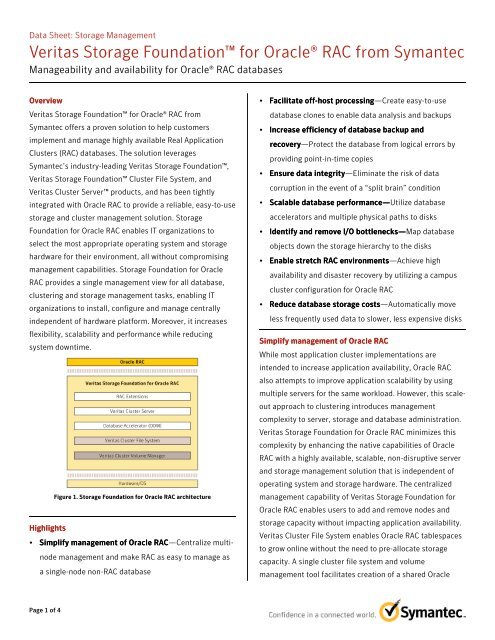
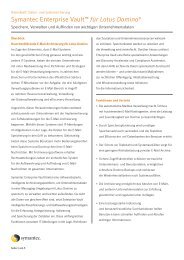
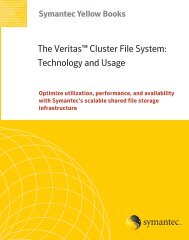
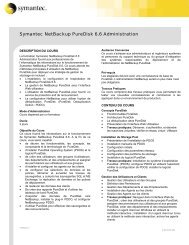
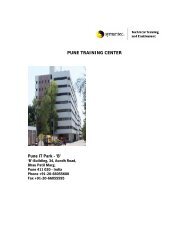
![xy The Numbers Don't Lie - New Page 1 [eval.symantec.com]](https://img.yumpu.com/11769670/1/190x259/xy-the-numbers-dont-lie-new-page-1-evalsymanteccom.jpg?quality=85)

